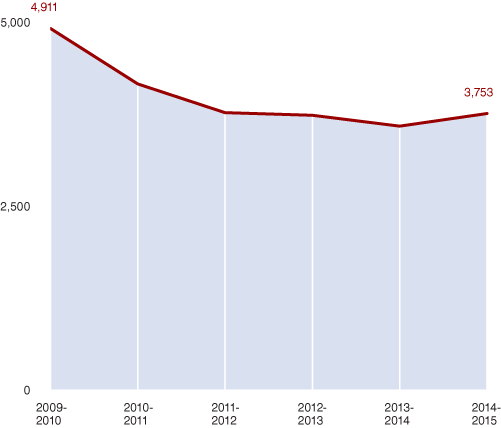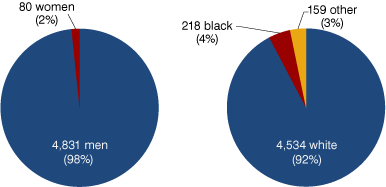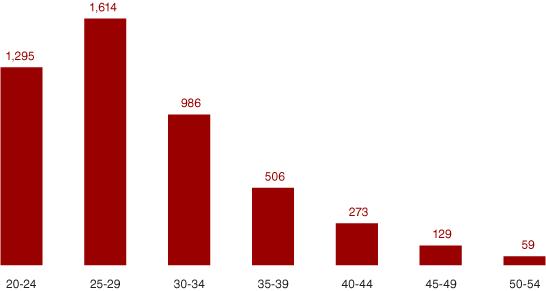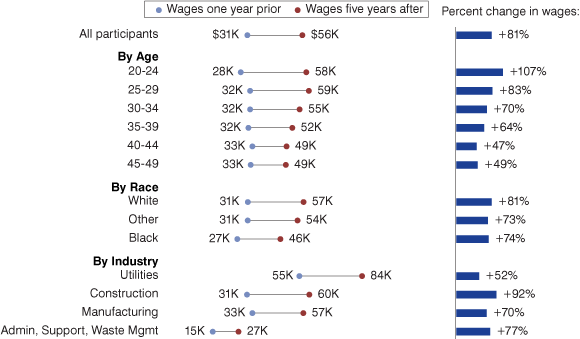Apprenticeship employment and wage outcomes

Teacher showing apprentice how to float cement.
Earlier this year, the White House described job-driven apprenticeship as being “among the surest pathways to provide American workers from all backgrounds with the skills and knowledge they need to acquire good-paying jobs and grow the economy.”1
David Audretsch, an economist at Indiana University, identified Germany’s apprenticeship system as one of the key components driving that country’s economic resurgence following sluggish growth in the 1990s.2
Apprenticeships offer a combination of classroom instruction and on-the-job training to provide workers with the knowledge and skills necessary to succeed in various occupations, usually construction trades such as electricians, carpenters and plumbers. Apprenticeships vary in length, but typically last about four years.3 At Ivy Tech Community College, apprentices are awarded an apprenticeship certificate from the U.S. Department of Labor and an Associate of Applied Science degree.
This article provides a first look at employment and wage outcomes from Ivy Tech’s apprenticeship program for participants in the 2009-2010 program year.4 Employment outcomes are measured by matching participants to state wage records in the year prior to the program year, and in each year following the program year. Measurable outcomes for each year include whether a participant was employed, what their annualized wages were and which industry they were employed in.
Participation in Ivy Tech apprenticeships
Ivy Tech’s apprenticeship programs saw a decrease in participants from nearly 5,000 in 2009-2010 to less than 4,000 in 2014-2015. But reassuringly, participant numbers began to stabilize in 2011 following the Great Recession. This article focuses on outcomes for the 4,911 participants during the 2009-2010 program year.
Figure 1: Number of Ivy Tech apprenticeship participants

Source: Indiana Department of Workforce Development
The vast majority of apprenticeship participants during the 2009-2010 program year were male (98 percent) and white (92 percent). About 4 percent were black and the remainder were of another race.
Figure 2: Race and gender of apprenticeship participants, 2009-2010 program year

Source: Indiana Department of Workforce Development
Apprenticeship participants also tend to be younger. Nearly 80 percent (3,895) of participants were in the 20-to-34 age group. Only 9 percent were between 40 and 54 years old.
Figure 3: Number of participants by age, 2009-2010 program year

Note: Some age groups are not shown to protect participant confidentiality.
Source: Indiana Department of Workforce Development
Employment outcomes
According to wage records, 3,974 of 4,911 participants (81 percent) were employed five years after program year 2009-2010. Employment rates were slightly higher among the 20-to-24 age group (83 percent) than in the older 50-to-54 age group (76 percent). The employment rate of black participants was 78 percent, slightly lower than the overall rate. Among other races (i.e., not white or black), only 57 percent were employed five years after the program year.
Table 1: Percent employed five years after 2009-2010 program year
| Category | Percent employed |
|---|---|
| All participants | 81% |
| Age | |
| 20 to 24 | 83% |
| 25 to 29 | 82% |
| 30 to 34 | 81% |
| 35 to 39 | 77% |
| 40 to 44 | 78% |
| 45 to 49 | 74% |
| 50 to 54 | 76% |
| Race | |
| White | 81% |
| Black | 78% |
| Other | 57% |
Source: Indiana Department of Workforce Development
The vast majority (72 percent) of employed participants ended up working in the construction industry. (Industry data were available for all but a few—0.3 percent—participants employed five years after the program year.) Approximately 11 percent worked in manufacturing, 4 percent in the administrative services, support and waste management sector, and 3 percent in utilities. The remaining 11 percent were spread across various sectors including retail trade, wholesale trade, transportation and warehousing, and various service industry sectors.
Figure 4: Top industries of employment, five years after 2009-2010 program year

Source: Indiana Department of Workforce Development
Wage outcomes
The most notable outcome among the 2009-2010 apprenticeship participants was the increase in wages for employed participants from one year prior to the program year to five years after the program year. Among all employed participants, wages increased from an average of $31,171 in the year prior to the program year to $56,374 five years after the program year. This is an increase of 81 percent (or 10.4 percent annual wage growth over six years).
Figure 5: Wage outcomes by age, race, and industry, 2009-2010 program year

Note: Represents average wages among employed participants in each time period.
Source: Indiana Department of Workforce Development
On average, younger participants saw larger wage increases. Wages jumped from $28,119 to $58,200 in the 20-to-24 age group (a 107 percent increase), while the 45-to-49 group saw a 49 percent increase from $32,686 to $48,781. Nevertheless, that 49 percent increase still represents a 6.9 percent annual growth rate over six years.
Nonwhite participants received somewhat smaller wage increases (73 to 74 percent) than white participants (81 percent).
Of the four most popular sectors of employment, the utilities sector stood out as a high-paying sector both for beginning wages and wages five years after the program year. Utilities employees saw a 52 percent wage increase from $55,012 to $83,707. This $28,695 increase was the largest of the four sectors.
Construction, the most popular industry of employment among apprenticeship participants, saw an increase from $31,004 to $59,529 (a 92 percent increase).
Wages of participants in the manufacturing sector rose 70 percent from $33,452 to $56,793, while participants in the low-wage administrative services sector experienced a 77 percent increase from $15,277 to $27,110.
The future of apprenticeship in Indiana
In Indiana, the future of apprenticeship is bright. Two of the most popular occupations for apprentices—electricians and plumbers—are also among the Hoosier Hot 50 list of Indiana’s fastest-growing, high-wage jobs of the future.5 These programs also tend to have some of the highest completion rates of all programs at Ivy Tech Community College.6
The Indiana Department of Workforce Development (DWD) sees apprenticeship as proven, on-the-job training that produces benefits for both apprentices and employers. DWD is committed to growing and expanding apprenticeship opportunities in the state, and was recently awarded a $200,000 ApprenticeshipUSA State Accelerator Grant by the U.S. Department of Labor. This grant will provide technical assistance for planning and developing Indiana’s state apprenticeship program.
In addition, the National Governor's Association Center for Best Practices selected Indiana as one of six states to participate in their Policy Academy on Work-Based Learning. Throughout this 18-month policy academy, Indiana will develop and refine strategies to elevate, define, enhance, scale and measure work-based learning opportunities that connect young adults (16-29) to quality work-based experiences.
DWD has submitted a formal proposal for up to $3 million in additional funding in the form of ApprenticeshipUSA State Expansion Grants from the U.S. Department of Labor. This funding would be used to expand and diversify registered apprenticeship opportunities in Indiana.
Visit www.mynextmove.org/ to find growing occupations with registered apprenticeship programs in Indiana.
Notes
- The White House, Office of the Press Secretary, “FACT SHEET: Investing $90 Million through ApprenticeshipUSA to Expand Proven Pathways into the Middle Class,” April 21, 2016, www.whitehouse.gov/the-press-office/2016/04/21/fact-sheet-investing-90-million-through-apprenticeshipusa-expand-proven.
- Indiana University press release, “IU Economist Reveals 'Seven Secrets' for Germany's Resurgence, Highlights Lessons for U.S.” October 21, 2015, http://news.indiana.edu/releases/iu/2015/10/germany-seven-secrets-book.shtml.
- U.S. Bureau of Labor Statistics, “Apprenticeship: Earn While You Learn,” Summer 2013, www.bls.gov/careeroutlook/2013/summer/art01.pdf.
- This includes anyone participating in an apprenticeship during the year, regardless of how far they are into the apprenticeship or whether they ultimately completed the program.
- View all of the Hoosier Hot 50 Jobs at https://netsolutions.dwd.in.gov/hh50/joblist.aspx.
- Indiana Commission for Higher Education, “Strengthening Indiana’s Community College System: A Report in Response to House Enrolled Act 1001-2015,” December 10, 2015, https://www.in.gov/che/files/Ivy_Tech_Report_and_Recommendations_12-10-15_FINAL.pdf.
